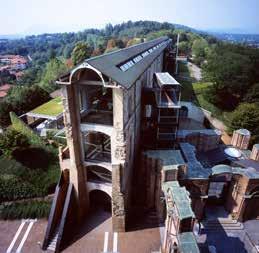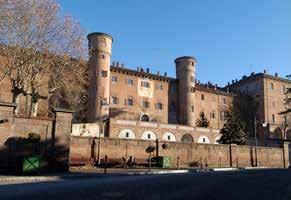
7 minute read
TOP DESTINATIONS AROUND PIEDMONT
CASTELLO DI RIVOLI
Established as a military fortress in 1247, the Rivoli Castle was the first residence of the Savoy duchy. During the 17th century, it was converted into an aristocratic residence, and enlarged with the addition of a wing known as the Manica Lunga, with the ducal picture gallery. Its imposing spaces are now the headquarters of a Museum of Contemporary Art, which also hosts temporary exhibitions. The courtyard of the castle is also home to Combal. Zero, a contemporary starred restaurant whose panoramic glass walls offer glorious views across the countryside as well as the surrounding castle. www.castellodirivoli.org
Advertisement
© OLGYSHA/SHUTTERSTOCK.COM
Castello di Rivoli

THE ROYAL VILLAS
With the trend for holidays, the Royal House of Savoy spends long periods in welcoming country residences surrounded by greenery. In fact, the Royal Apartments of Borgo Castello are located within La Mandria Park, while Racconigi Castle, officially established as a holiday residence, opens onto the town and the extraordinary romantic park, which includes greenhouses and now also a nature reserve. For the same purpose, at the end of the eighteenth century the castles of Govone and Agliè were purchased and in the nineteenth century the Tenuta Reale di Pollenzo, now the seat of the University of Gastronomic Sciences. www.residenzereali.it
Castello di Moncalieri Castello della Mandria


Castello di Agliè Castello di Rivoli (Manica Lunga)


Sunset over the vineyards of the Langhe, Barolo and La Morra area
Avant-garde wineries, a legacy of world-class cuisine and marvelous landscapes. All of these things have earned the areas of the Langhe, Roero and Monferrato UNESCO World Heritage status, resulting in an elite tourist destination.
This is UNESCO’s official reason for adding the wine-growing regions of the Langhe-
Roero and Monferrato
to its world heritage list in 2014. “An exceptional living testimony to the historical tradition of grape growing and winemaking processes, of a social context, and a rural economy based on viticulture. The vineyards of the LangheRoero and Monferrato are an outstanding example of man’s interaction with his natural surroundings.” This area is protected as a ‘cultural heritage’ which is symbolic, because man has managed to shape it, giving it the unique characteristics that it boasts today. In this area, the vineyards of several of the world’s most famous wines, including Barolo, Barbaresco, Asti Spumante and Barbera, stretch as far as the eye can see, in a display of changing colours and softly rolling hills. Although geographically the Langhe, Roero and Monferrato are neighbouring regions, they all have different morphologies, and cultural characteristics. The region’s varied landscape provides fertile soil for an impressive array of local specialties: from superlative wine, to the prized white truffles of Alba, porcini mushrooms and IGP hazelnuts. Located just an hour’s drive from Turin, these regions can be accessed by car (several of the larger centres can also be reached by train). Other options include one of the many organized wine and tasting tours on offer.
THE LANGHE
The Langhe are situated between the Tanaro River and Liguria, between the provinces of Asti and Cuneo. Particularly noteworthy among the area’s many tourist attractions are its numerous castles, including that of Grinzane Cavour. Built in the 13th century and currently home to the headquarters of the ‘Cavour Regional Enoteca’, the castle, in addition to stocking several of the region’s finest Doc and Docg wines, also hosts the interesting Langhe Museum (www.castellogrinzane.com). Other must-sees include the Castle of Barolo and its surrounding town, which gives its name to the most famous Italian red wine and is thought to date back to mediaeval times. The town is home to WiMu, a unique wine museum that takes visitors on an immersive journey through the history of viticulture via light, film and installations. The museum is set over three floors of the village’s stunning medieval castle, and the tour includes a visit to the building’s panoramic terrace and its ancient wine
Barolo village

VENTDUSUD/ SHUTTERSTOCK.COM ©
Cobblestone old town square and medieval towers in Alba

ROSTISLAV GLINSKY/ SHUTTERSTOCK.COM ©
cellars (www.wimubarolo.it). After visiting the museum in Barolo, stop in the village of La Morra, better known as ‘the terrace of the Langhe’ thanks to its spectacular views, and head to Massimo Camia’s starred restaurant for a fabulous gourmet meal (www.massimocamia.it). In addition to other specialties, the area is renowned for its famous three-lobed hazelnut, boasting ‘Protected Geographical Indication’ status and used to make various sweet treats. If you want to purchase these tantalizing specialties and see how they’re made, visit Giovanni Cogno’s artisanal workshop (www.giovannicogno.it). Lastly, an absolute ‘must’ for lovers of medieval history and architecture is a visit to the Castle of Serralunga d’Alba, a beautifully preserved Gothic stronghold (www. castellodiserralunga.it). After the long walk up to the castle, take a break and treat yourself to a delicious gourmet meal at the Da Guido restaurant located in the nature reserve of Fontanafredda (www.guidoristorante.it).
Eco Museum - infernot
MONFERRATO
Stretching southwards, as far as the foot of the Ligurian Appenines, the Monferrato area occupies a fertile tract of terrain between the provinces of Alessandria and Asti. In addition to numerous historic, cultural and outdoor activities, Monferrato is renowned for its gastronomic specialties. Nature, culture, art and religion combine in a walk that takes visitors on a journey to discover the Nature Park of the Sacro Monte di Crea, in the province of Alessandria, a real feat of architectural design that encompasses Mount Crea and its sanctuary, which in turn, is a UNESCO World Heritage site. If you prefer a historical visit to an excursion, don’t miss the Eco Museum of ‘Pietra da Cantone’ – a type of sandstone only found in this area – in Cella Monte. For some years now, the museum has undertaken the arduous but worthwhile task of taking an inventory of the ‘infernot’ in the area. ’Infernot’ are dark, airless underground spaces, carved out in stone, located beneath houses and cellars

that, in some instances, are real underground tunnels. These works of arts, carved and modeled by artists, were either used to store bottles of wine, or as pantries, because the temperature inside them remains constant. Several of these old ‘infernot’ are open for public viewing, especially during the ‘vendemmia’ (grape harvest) or on special occasions (www. ecomuseopietracantoni.it). Although the majority of local wines are red and full-bodied, like Barbera, Grignolino and Freisa, you’ll also find a good selection of whites, including Moscato. An absolute ‘must’ for wine connoisseurs visiting the area is the Enoteca Regionale di Vignale Monferrato. Located in a magnificent 17th century ‘palazzo’, the Enoteca is a great place to taste and purchase some of the area’s best local wines (www.enotecadelmonferrato.it).
Castle of Govone

S74/ SHUTTERSTOCK.COM ©
ROERO
The Roero area is situated in the northeastern part of the province of Cuneo and is renowned for its
enogastronomic and
cultural offerings. Among its castles, the Castle of Govone was formerly one of the royal residences of the House of Savoy (www. castellorealedigovone.it). Located just a short distance from Alba, the Castle of Monticello is one of the most imposing and bestpreserved medieval buildings (www.roerodimonticello.it). Experience what it feels like to be a prince or princess for one night and stay at the Castle of Guarene, an important stopover on the Piedmontese Baroque itinerary which also hosts a hotel belonging to the Relais&Châteaux chain (www.castellodiguarene.com). Only a few kilometers from Bra, a trip to the architectural complex of the Agenzia di Pollenzo is well worth your time. Built in 1833, it now hosts the first University of
Gastronomic Sciences in
the world. This university was founded and promoted by the international Slow Food association, which studies, protects and disseminates the agricultural and enogastromic traditions of countries worldwide (www.agenziadipollenzo.com).
Castle of Guarene










